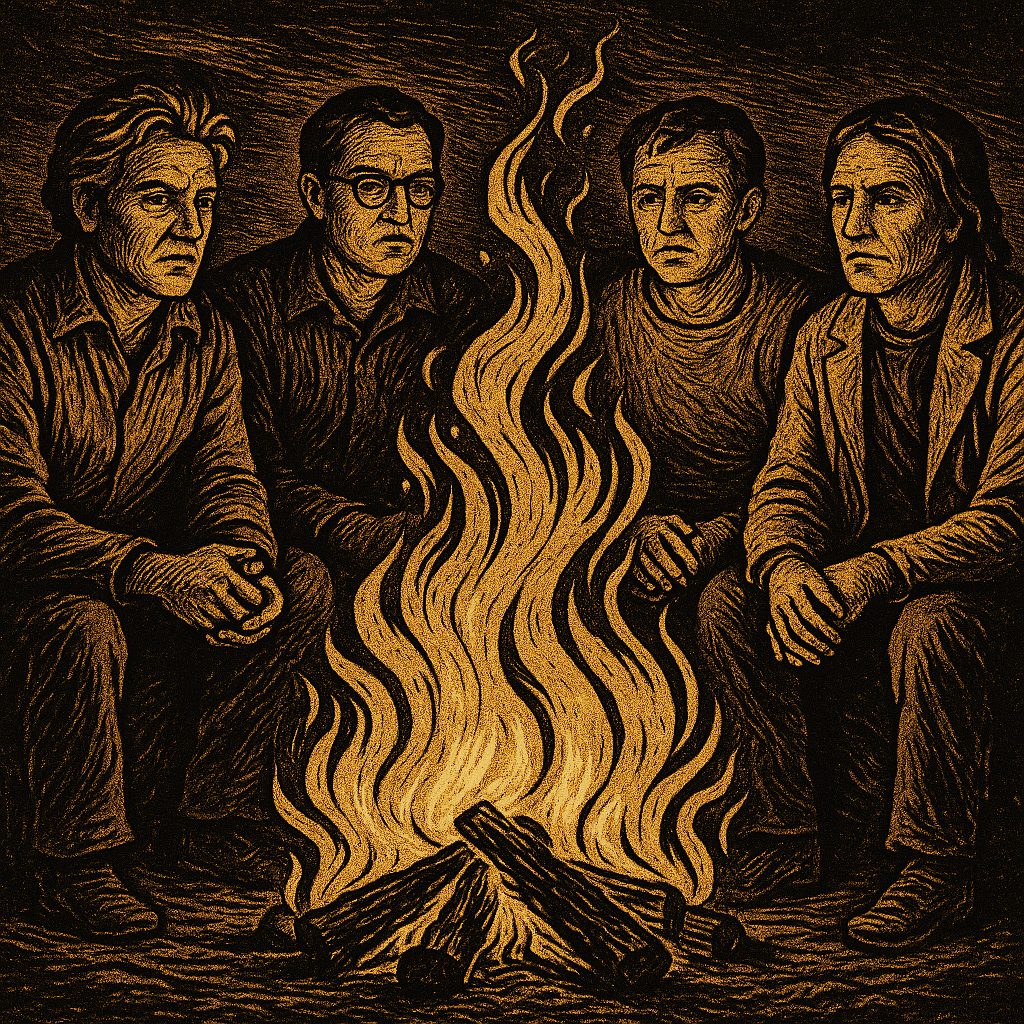
WARNING: This post contains plot spoilers for the film, The Mastermind (2025)!
If I were to hold a retreat for entitled men, I’d start with a fire. No agenda, no worksheets, just flames licking the dusk, the smoke catching in our eyes. Then I’d tell them a story.
It’s the story of a happy family man who wanted more. Not more love or laughter, but more status. A man with a wife, two children, a carpentry business, and a hollow ache that told him he was meant for something greater.
One night, talking to a college professor he once admired, he’s told about a set of Arthur Dove paintings in a local museum: rare, abstract, luminous. “You could do something meaningful,” the professor says. “Retrieve them.”
So he begins to plan a heist. Not for money, but for purpose. He becomes obsessed — staring at the paintings after work, tracing their shadows, believing they hold the key to his life. To carry out the theft, he recruits a gang of lost young men, uses his wife and kids as cover, manipulates everyone in his orbit.
When suspicion falls, he flees to the countryside, hiding out with an old friend — a substitute teacher, another lost man — and the friend’s wife, Maude. She sees him clearly and says one quiet, devastating line:
“Don’t come back. You’ve put everyone in danger.”So he runs again. He calls his wife, not to confess but to beg for money. When she refuses, he mugs an old woman, only to be caught when he blunders into an anti–Vietnam War protest. A protester picks up the purse he’s dropped and hands it back to him, kindly. He’s then arrested for being part of the protest, not the mugging. He’s finished. The dream is over.
This is Kelly Reichardt’s The Mastermind (2025), a film of quiet devastation. Set in the burnt ochres and damp greens of 1970s Massachusetts, it tells a story that is not really about crime at all, but about male delusion.
For anyone working with men — in education, therapy, or creative practice — The Mastermind is a parable about emotional needs gone awry. It’s also, through the lens of the Human Givens approach, a near-perfect case study in what happens when those needs are not met in balanced, healthy ways.
Instrumentalised Creativity: When Imagination Becomes Manipulation
In The Mindful Creative Writing Teacher (Gilbert, 2024, pp. 184–187), I describe what I call instrumentalised creativity — when imagination becomes a means to manipulate, rather than to connect.
“Mooney’s heist is precisely that: a creative act stripped of meaning, a performance of genius that leaves wreckage behind.”
In Human Givens language, Mooney has lost touch with his innate resources: his capacity for rationality, imagination, pattern recognition, and observing his ‘self’. His creative energy has turned inward, feeding ego rather than expression.
I’ve been completing Human Givens training this year, and the clarity it offers is remarkable. Griffin and Tyrrell (2003) identify nine essential emotional needs: for security, attention, autonomy, status, intimacy, community, meaning, competence, and privacy. When these needs are unmet or unbalanced, we become anxious, impulsive, or depressed. Mooney’s tragedy is the perfect illustration.
1. When Status Replaces Meaning
Mooney’s entire heist is a plea to be seen. He’s driven not by greed but by an unmet need for status and significance.
“He mistakes admiration for love, recognition for worth.”
Human Givens theory frames status as an essential social nutrient — something we all require, but which must be earned through contribution, not performance. When this need goes unmet, we fabricate dramas to assert our value.
For many men today, this is painfully familiar. They perform competence, chase admiration, or inflate their self-image instead of finding belonging. The therapeutic task is to shift from status to meaning: to find worth through genuine connection and service.
A simple writing prompt can open this insight:
“Write about a moment when you felt unseen, and what you did next.”
The act of noticing reveals the difference between needing recognition and needing respect.
2. Control Is Not Safety
After the theft, Mooney becomes paranoid — trying to manage every variable, every person. His mind is a storm of hypervigilance. He believes that control equals safety.
The Human Givens approach reframes this entirely: safety arises from trust and connection, not from control. We need environments that feel secure enough to permit vulnerability.
For many men conditioned to equate mastery with safety, this is a revelation. The Human Givens model teaches that an anxious mind is a pattern-seeking mind out of balance — it’s using its resource of imagination to catastrophise rather than to problem-solve.
A creative exercise I often use in workshops: write a scene twice — once with the character controlling everything, then again with them relinquishing control. The second version often feels more human, more real.
“True security arises not from dominance but from dependable connection.”
3. Boundaries Are Acts of Care
Maude’s refusal — “Don’t come back” — is the moral hinge of the film. It’s not cruel; it’s truthful. She reclaims her autonomy through clear boundary-setting.
The Human Givens model treats boundaries as essential to emotional health. They protect our needs for respect and security. Mooney’s collapse comes from the erosion of all boundaries: between honesty and deceit, love and manipulation, fantasy and fact.
Teaching or therapy informed by Human Givens can model this kind of clarity. Writing prompts such as
“Describe a time when saying no was an act of love”
help clients or students understand that refusal can be restorative.
“A boundary is not a wall, but a line that keeps care alive.”
4. Recovery Begins with Noticing
By the final act, Mooney drifts through the protest crowd, stripped of all pretence. Reichardt films him as if he were a ghost, neither villain nor victim — just a man who can finally see himself.
This moment of awareness — what Human Givens calls the observing self — is where healing begins. It’s the part of us that can notice our thoughts and feelings without being swept away by them. In HG practice, helping a client access this observing self is often the turning point in recovery.
In mindful writing, the same principle applies. A prompt such as
“Write a confession your character has never spoken aloud”
encourages the writer to step outside the narrative of justification and simply notice what’s true.
“Awareness is the first act of recovery; it’s the point where the story stops running you, and you start writing it.”
The Mindful Lesson
The Mastermind is not really about theft; it’s about need — and what happens when those needs are distorted. Its muted palette, its refusal of spectacle, its patient attention to delusion, all evoke the 1970s realism of Cassavetes or Ashby. It’s a film that invites stillness and moral reckoning.
Human Givens therapy calls this reality orientation: the return from fantasy to grounded perception. Reichardt’s Mooney is the lost man who cannot tell the difference between imagination and life — a danger that all creative people face in smaller ways.
As I argue in The Mindful Creative Writing Teacher (Gilbert, 2024), the work of the mindful educator or therapist is to guide people back toward authenticity —
“to use imagination not to escape reality, but to see it more clearly.”
Every act of making — whether art, relationship, or identity — must be balanced by awareness of need. Otherwise, creativity becomes control, and empathy turns to performance.
Around that campfire, at the retreat for entitled men, I’d end the story here. I’d let the silence do its work. And I’d ask only one question:
What is it you really need?


Leave a Reply